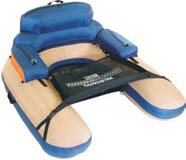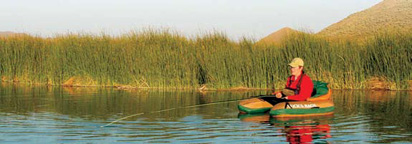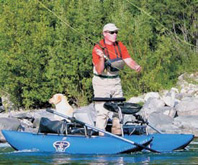Float Tubes and Pontoon Boats


Float tubes offer still water anglers tremendous advantages. Their soft nylon/neoprene and water junctions dampen sound production and keep your movements quiet. You still need to pay attention to shadows, but because you sit low in the water your compact silhouette is more difficult for the fish to spot than the silhouette of a standing and moving shoreline angler. Generally speaking, float tubes allow for an effective close approach without alarming the fish.
Float tubes provide access to waters otherwise unreachable like brush-choked or boggy shorelines where fish often cruise for minnows and nymphs, but float tubes can also give you easy and lethal access to offshore areas such as weed beds, submerged springs, ledges, and islands. Because the tube, waders, and fins can weigh less than twelve pounds, a float tube is highly mobile and can be backpacked into remote lakes and ponds. Float tubers can easily access hundreds of places inaccessible to conventional boats that must be trailered or portaged. In addition, many waters closed for motorized craft are open to float tubing. Hence, a float tube is ideal for the still water fly rodder because it offers us a close approach to places we could otherwise never fish. Because float tubes are propelled and steered by fins on your feet, they leave both hands free to fish.
Select a float tube in the medium to high price range. Quality craft feature double or triple stitching of durable nylon with non-corrosive zippers immune to rust. With a quick-draining mesh bottom, the float tube can readily dry off for transport inside your automobile. A stripping apron assists fly rodders with their casting by providing a dry place to hold strips of fly line in tangle-free coils. A double backrest provides a comfortable


back support, additional floatation, and storage for a lunch, drinking water, and perhaps an extra reel. A deep seat adds to the comfort level of a good float tube. In addition, ample side pockets furnish plenty of storage areas for easily accessed gear like extra fly boxes, pliers, insect net, sun block lotion, and the like. Consequently, you can keep a complete assortment of tackle, rain gear, and a camera at your fingertips while fishing. Moreover, a suspender system and backpack straps attached by detachable D-rings make transporting the tube–as well as entering and exiting the water–not only convenient but safe.
Neoprene waders are preferable to conventional waders for many float tube anglers because neoprene insulates you from the cold water temperatures, especially on early spring and late fall mornings and evenings. Neoprene booties worn over stocking foot waders provide extra comfort, protection, and warmth. If neoprene waders spring a leak, the inside water soon warms from the angler’s body heat and therefore permits some degree of comfort.
Fins should be heavy duty and, most importantly, properly fitted. Overly tight fins will cut circulation and your feet will quickly become cold. A safety strap on comfortably fitting fins will prevent their loss should one or both of the fins ever become displaced in the water. If lost, floating fins are obviously much easier to find than sinking models, and some fins are even designed to fit over boot foot waders. Force fins are efficient to use, and because they curve upwards, they tolerate some land walking.
For safety’s sake float tubes are limited to still water use and not for river usage. In fast currents float tubes are dangerous because your feet can snag on underwater obstructions making the craft treacherous to control.
A secondary floatation chamber is insurance against a leaking tube. A coast guard approved life preserver should be either worn or stored for ready access. A flashlight is a must for dawn, dusk and night time float tubing.
Float tubes are available in doughnut shapes, open fronted U boat designs, and pontoon craft models. The doughnut style is the least expensive float tube; in addition, their high backs and side pockets keep out splashing waves.
Useful accessories include a mesh creel, Velcro rod holders, anchor systems, insulated drink holders and video depth sonar (a “fish finder”).
Avoid either over-inflating or under-inflating the tube. Optimal air pressure is 3-4 lbs; use a float tube gauge to check your air pressure. Inflate the tube until the wrinkles on the covering are just evened out. Under-inflation causes the float tube to ride so low in the water that it is burdensome to propel. Because sun exposure increases the air pressure, over-inflation may split the float tube’s cover.
Open-ended (U-boat) designs allow for easier entries and exits on the water, and consequently they are safest in emergencies because they permit speedier exits. In addition, U-boat designs are easier to propel than the dough-nut-shaped float tubes, which means they are faster on the water, and finally, their general open-end design offers more comfort to the fly rodder than the doughnut-shaped float tubes because the U-boats free your legs to kick and move whereas the doughnut shape somewhat constricts leg movement. In addition, U-boat bladders weigh less than the rubber truck inner tubes used in doughnut float tubes, which means they can be inflated by mouth, an advantage that negates the necessity for an air pump, which is both heavy and cumbersome to pack. Consequently, U-boat float tubes are ideal for backpacking use because air pumps are both heavy and cumbersome to pack. One slight disadvantage is that their open fronts don’t allow you to lean on them to steady your elbows.

Pontoon boats are propelled by either fins or oars. They allow you to sit up higher in the water and rest your feet. The higher sitting position allows for easier casting. In fact, because pontoon boats come equipped with seats and rests, they are the most comfortable personal watercraft. Perhaps best of all, pontoon boats can be used on both streams and lakes: big rivers, small rivers, some big creeks, and almost all lakes and ponds. Some models of pontoon boats can safely navigate class III rapids. Streams can be fished with both hands free because the boat can be controlled by the fins. Easy exit and entry is another advantage.
A float tube’s inherent safety features are that they catch less wind than a boat. Also, the low profile and large keel (legs) make them stable by being difficult to capsize. Air leaks usually tend to be slow and permit anglers sufficient time to reach shore. Nevertheless, you should carefully inspect and examine the tube twice a year for cracks and sunlight deterioration.
Needless to say, perhaps, it is dangerous to flip over in a float tube, and although this rarely happens, if it does a fast exit is the best medicine. Regardless of the design you choose, make sure it comes with a

quick release buckle.
Lightning strikes are one of my primary fears on the water because a sudden thunderstorm can find you far from shore. Since you are the highest profile around and you are holding a lightning rod (graphite) in your hand, your danger is real. Anticipate storms by quickly getting off the water before the storm can reach your position.
Here again, as in all fly fishing situations, use common sense. In some regions of the country alligators and cottonmouth snakes may pose a threat to anglers. On salt water, a shark may even be attracted to the seal-like movements of an angler in a float tube. Exercise caution with float tubes and pontoon boats wherever you are.


© 2025 The Gale Group, Inc. All rights reserved.
© 2025 Perigee Learning LLC. All rights reserved.
LoveTheOutdoors.com is owned and operated by Advameg, Inc. © 2025 Advameg, Inc.
Camping Adventures • Dutch Oven Cooking • Sports Knots
Fly Tying • Freshwater Fishing • Fly Fishing

